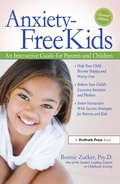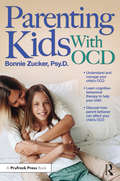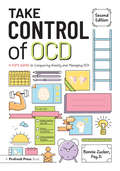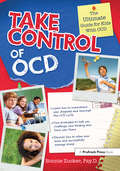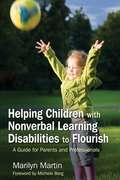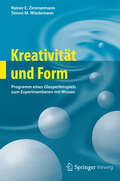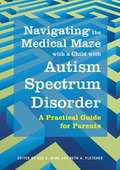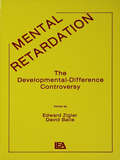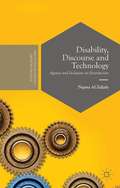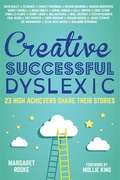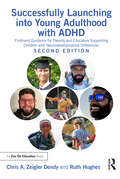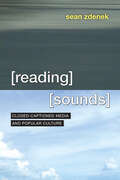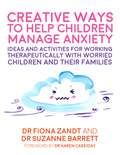- Table View
- List View
Anxiety-Free Kids: An Interactive Guide for Parents and Children
by Bonnie ZuckerAnxiety-Free Kids (2nd ed.) offers parents strategies that help children become happy and worry-free, methods that relieve a child's excessive anxieties and phobias, and tools for fostering interaction and family-oriented solutions. Using a unique companion approach that offers two books in one—a practical, reader-friendly book for parents and a fun workbook for kids—this solutions-oriented guide utilizes the cognitive-behavioral approach to therapy and integrates the parent in the child's self-help process.Research has shown that if left untreated, children with anxiety disorders are at higher risk to perform poorly in school, to have less-developed social skills, and to be more vulnerable to substance abuse. Covering the six most commonly occurring anxiety disorders—generalized anxiety, separation anxiety, specific phobias, social phobias, panic disorder, and obsessive-compulsive disorder—this book gives kids and parents successful strategies for achieving relaxation, conquering worries, challenging faulty thinking patterns, developing positive self-talk, and facing one's fears.Educational Resource
Anxiety-Free Kids: An Interactive Guide for Parents and Children
by Bonnie ZuckerAnxiety-Free Kids (2nd ed.) offers parents strategies that help children become happy and worry-free, methods that relieve a child's excessive anxieties and phobias, and tools for fostering interaction and family-oriented solutions. Using a unique companion approach that offers two books in one—a practical, reader-friendly book for parents and a fun workbook for kids—this solutions-oriented guide utilizes the cognitive-behavioral approach to therapy and integrates the parent in the child's self-help process.Research has shown that if left untreated, children with anxiety disorders are at higher risk to perform poorly in school, to have less-developed social skills, and to be more vulnerable to substance abuse. Covering the six most commonly occurring anxiety disorders—generalized anxiety, separation anxiety, specific phobias, social phobias, panic disorder, and obsessive-compulsive disorder—this book gives kids and parents successful strategies for achieving relaxation, conquering worries, challenging faulty thinking patterns, developing positive self-talk, and facing one's fears.Educational Resource
Parenting Kids With OCD: A Guide to Understanding and Supporting Your Child With OCD
by Bonnie ZuckerParenting Kids With OCD provides parents with a comprehensive understanding of obsessive-compulsive disorder, its symptoms, types, and presentation in children and teens. The treatment of OCD is explained, and guidelines on how to both find appropriate help and best support one's child are provided. Family accommodation is the rule, not the exception, when it comes to childhood OCD; yet, higher accommodating is associated with a worsening of the child's symptoms and greater levels of familial stress. Parents who have awareness of how they can positively or negatively impact their child's OCD can benefit their child's outcome. Case examples are included to illustrate the child's experience with OCD and what effective treatment looks like. OCD worsens when there is increased stress for the child; therefore, stress management is an essential component for improvement. Parents will learn how to manage stress in themselves and encourage effective stress management for their children.
Parenting Kids With OCD: A Guide to Understanding and Supporting Your Child With OCD
by Bonnie ZuckerParenting Kids With OCD provides parents with a comprehensive understanding of obsessive-compulsive disorder, its symptoms, types, and presentation in children and teens. The treatment of OCD is explained, and guidelines on how to both find appropriate help and best support one's child are provided. Family accommodation is the rule, not the exception, when it comes to childhood OCD; yet, higher accommodating is associated with a worsening of the child's symptoms and greater levels of familial stress. Parents who have awareness of how they can positively or negatively impact their child's OCD can benefit their child's outcome. Case examples are included to illustrate the child's experience with OCD and what effective treatment looks like. OCD worsens when there is increased stress for the child; therefore, stress management is an essential component for improvement. Parents will learn how to manage stress in themselves and encourage effective stress management for their children.
Take Control of OCD: A Kid's Guide to Conquering Anxiety and Managing OCD
by Bonnie ZuckerTake Control of OCD: A Kid's Guide to Conquering Anxiety and Managing OCD is a must-have guide for kids and teens ages 10-16 with Obsessive-Compulsive Disorder to help them take control and use their strengths to find success in school and in life. This fully updated second edition:Uses a cognitive-behavioral therapy and exposure/response prevention method to stress gradual exposure to obsessive thinking patterns.Provides a step-by-step ladder-based process to help readers conquer their fears and demolish their worries.Helps kids change their obsessive thoughts, tolerate uncertainty, and develop positive self-talk and stress management.Also helps kids advocate for their needs in school and build successful relaxation procedures.Includes workbook-style pages for readers to complete.By interviewing kids with OCD from across the country, the author offers tons of advice, information, and ideas for students, by students just like them. Readers will find themselves in this book, as it normalizes and validates the often hidden and undisclosed thoughts, urges, and images, and accompanying rituals and compulsions that so many children and teens with OCD struggle with.Ages 10-16
Take Control of OCD: A Kid's Guide to Conquering Anxiety and Managing OCD
by Bonnie ZuckerTake Control of OCD: A Kid's Guide to Conquering Anxiety and Managing OCD is a must-have guide for kids and teens ages 10-16 with Obsessive-Compulsive Disorder to help them take control and use their strengths to find success in school and in life. This fully updated second edition:Uses a cognitive-behavioral therapy and exposure/response prevention method to stress gradual exposure to obsessive thinking patterns.Provides a step-by-step ladder-based process to help readers conquer their fears and demolish their worries.Helps kids change their obsessive thoughts, tolerate uncertainty, and develop positive self-talk and stress management.Also helps kids advocate for their needs in school and build successful relaxation procedures.Includes workbook-style pages for readers to complete.By interviewing kids with OCD from across the country, the author offers tons of advice, information, and ideas for students, by students just like them. Readers will find themselves in this book, as it normalizes and validates the often hidden and undisclosed thoughts, urges, and images, and accompanying rituals and compulsions that so many children and teens with OCD struggle with.Ages 10-16
Take Control of OCD: The Ultimate Guide for Kids With OCD
by Bonnie ZuckerTake Control of OCD: The Ultimate Guide for Kids With OCD is a unique guide just for kids ages 10-16 with Obsessive-Compulsive Disorder to help them take control of their disorder and find success in school and in life. Using a cognitive-behavioral therapy method to stress gradual exposure to students' obsessive thinking patterns, the book takes kids step-by-step through a ladder-based process to conquer their fears and demolish their worries.Focusing on helping kids change their obsessive thoughts, tolerate uncertainty, develop positive self-talk and stress management, advocate for their needs in school, find successful relaxation procedures, and face their fears, the book includes workbook-style pages for kids to complete. By interviewing kids with OCD from across the country, the author offers tons of advice, information, and ideas for students, by students just like them. This handy guidebook is sure to help children with OCD change their behaviors and conquer their worries, discovering a sense of accomplishment and achievement.Ages 10-16
Take Control of OCD: The Ultimate Guide for Kids With OCD
by Bonnie ZuckerTake Control of OCD: The Ultimate Guide for Kids With OCD is a unique guide just for kids ages 10-16 with Obsessive-Compulsive Disorder to help them take control of their disorder and find success in school and in life. Using a cognitive-behavioral therapy method to stress gradual exposure to students' obsessive thinking patterns, the book takes kids step-by-step through a ladder-based process to conquer their fears and demolish their worries.Focusing on helping kids change their obsessive thoughts, tolerate uncertainty, develop positive self-talk and stress management, advocate for their needs in school, find successful relaxation procedures, and face their fears, the book includes workbook-style pages for kids to complete. By interviewing kids with OCD from across the country, the author offers tons of advice, information, and ideas for students, by students just like them. This handy guidebook is sure to help children with OCD change their behaviors and conquer their worries, discovering a sense of accomplishment and achievement.Ages 10-16
Helping Children with Nonverbal Learning Disabilities to Flourish: A Guide for Parents and Professionals
by Marilyn Martin Zion`Imagine getting lost in your own home, forgetting where the bathroom is at work, or being unable to operate a simple door knob. These are just some of the myriad challenges faced by individuals with a Nonverbal Learning Disability, or NLD...In Helping Children With Non-Verbal Learning Disabilities to Flourish, Marilyn Martin gives an overview of NLD and strategies for teaching individuals with this disability. Using examples of her struggles to help her daughter, who has NLD, as well as current research, she has written a book helpful for both parents and professionals. In addition to her experiences with her daughter, Martin is a Learning Specialist with more than fifteen years of experience working with students who have dyslexia, NLD, and other learning disorders... This book is a good introduction to NLD and interventions for treating it... As it gains recognition as a distinct learning disorder, interventions and informative books, like this one, will open doors, literally and figuratively, for families and individuals touched by NLD.' - Foreword, Autumn 2007 `Author Marilyn Martin's daughter Sara was diagnosed with Nonverbal Learning Disability (NLD). Marilyn offers a comprehensive developmental profile of children with NLD and explores the controversies surrounding the condition so parents and professionals can identify learners with NLD and ensure they receive early intervention. Offering practical advice on NLD at home and at school, the book describes step by step interventions for improving a range of skills from penmanship to social acumen.' -Autism Us, 2007 `Marilyn Martin's book Helping Children with Nonverbal Learning Disorder to Flourish is an exciting and essential new addition to the literature. ... Martin shines in her ability to match interventions to a broad range of problems and examples abound in every chapter. Clear, concise, and detailed explanations are given so that the interventions can be applied skillfully. ... Each intervention is presented in a terrifically useful and usable format that includes the problem, strengths available, proposed solution, how the solution can be generalized, the goal of the intervention, and a very up-to-date and helpful listing of relevant resources.' - from the Foreword by Michele Berg, Director, Center for Learning Disorders, Family Service and Guidance When you continuously cannot find the bathroom in your best friend's house, or you cannot print the letter `t' when all your friends are writing volumes, you notice, and you ask questions. So it was for Marilyn Martin's daughter, Sara, who was diagnosed with Nonverbal Learning Disability (NLD). This book skilfully combines a comprehensive guide to NLD with the inspiring story of how Sara transformed herself from that young girl whose existence seemed darkened by learning difficulties into the capable young woman she is today. In Helping Children with Nonverbal Learning Disabilities to Flourish, Marilyn Martin presents a comprehensive developmental profile of children with NLD. She explores the controversies surrounding the disorder so parents and professionals can identify learners with NLD and insure they receive early intervention. Offering practical advice on NLD at home and at school, she describes step-by-step interventions for improving a range of skills from penmanship to social acumen. This book is essential reading for parents and professionals working with children with NLD.
Helping Children with Nonverbal Learning Disabilities to Flourish: A Guide for Parents and Professionals (PDF)
by Marilyn Martin Zion`Imagine getting lost in your own home, forgetting where the bathroom is at work, or being unable to operate a simple door knob. These are just some of the myriad challenges faced by individuals with a Nonverbal Learning Disability, or NLD…In Helping Children With Non-Verbal Learning Disabilities to Flourish, Marilyn Martin gives an overview of NLD and strategies for teaching individuals with this disability. Using examples of her struggles to help her daughter, who has NLD, as well as current research, she has written a book helpful for both parents and professionals. In addition to her experiences with her daughter, Martin is a Learning Specialist with more than fifteen years of experience working with students who have dyslexia, NLD, and other learning disorders… This book is a good introduction to NLD and interventions for treating it… As it gains recognition as a distinct learning disorder, interventions and informative books, like this one, will open doors, literally and figuratively, for families and individuals touched by NLD.' - Foreword, Autumn 2007 `Author Marilyn Martin's daughter Sara was diagnosed with Nonverbal Learning Disability (NLD). Marilyn offers a comprehensive developmental profile of children with NLD and explores the controversies surrounding the condition so parents and professionals can identify learners with NLD and ensure they receive early intervention. Offering practical advice on NLD at home and at school, the book describes step by step interventions for improving a range of skills from penmanship to social acumen.' -Autism Us, 2007 `Marilyn Martin's book Helping Children with Nonverbal Learning Disorder to Flourish is an exciting and essential new addition to the literature. … Martin shines in her ability to match interventions to a broad range of problems and examples abound in every chapter. Clear, concise, and detailed explanations are given so that the interventions can be applied skillfully. … Each intervention is presented in a terrifically useful and usable format that includes the problem, strengths available, proposed solution, how the solution can be generalized, the goal of the intervention, and a very up-to-date and helpful listing of relevant resources.' - from the Foreword by Michele Berg, Director, Center for Learning Disorders, Family Service and Guidance When you continuously cannot find the bathroom in your best friend's house, or you cannot print the letter `t' when all your friends are writing volumes, you notice, and you ask questions. So it was for Marilyn Martin's daughter, Sara, who was diagnosed with Nonverbal Learning Disability (NLD). This book skilfully combines a comprehensive guide to NLD with the inspiring story of how Sara transformed herself from that young girl whose existence seemed darkened by learning difficulties into the capable young woman she is today. In Helping Children with Nonverbal Learning Disabilities to Flourish, Marilyn Martin presents a comprehensive developmental profile of children with NLD. She explores the controversies surrounding the disorder so parents and professionals can identify learners with NLD and insure they receive early intervention. Offering practical advice on NLD at home and at school, she describes step-by-step interventions for improving a range of skills from penmanship to social acumen. This book is essential reading for parents and professionals working with children with NLD.
Kreativität und Form: Programm eines Glasperlenspiels zum Experimentieren mit Wissen
by Rainer E. Zimmermann Simon M. WiedemannAusgehend von der Idee des Glasperlenspiels, die Hermann Hesse in seinem gleichnamigen Roman entwirft, haben die Autoren in diesem Band die Möglichkeiten und Grenzen eines solchen Spiels im Umgang mit Wissen ausgelotet. Sie zeigen neue Methoden für das Wissensmanagement auf und verbinden dafür Erkenntnisse verschiedener Wissenschaftsgebiete wie Logik, System- und Erkenntnistheorie sowie Semiotik, Kognition und Kommunikation. Das begleitende Computerprogramm unterstützt Leser beim Experimentieren mit Wissen.
Navigating the Medical Maze with a Child with Autism Spectrum Disorder: A Practical Guide for Parents (PDF)
by Barbie Zimmerman-Bier Beth Pletcher Caroline Hayes-Rosen Devorah Segal Evan Spivack Gary Mcabee Harumi Jyonouchi Iona Monterio Jeffrey Kornitzer Jennifer Bain Julie O'Brien Lisa Ford Mark D. Robinson Sue Ming Susan Brill Susan Connors Thomas Ballesteros Tishi ShahThis comprehensive guide enables parents of children with an autism spectrum disorder (ASD) to play an active and effective role in their child's medical care from diagnosis to early adulthood. With a focus on working with health care providers to ensure the best treatment for your child's unique needs, it includes: - a description of the developmental and medical conditions faced by children with ASDs in lay terms - an explanation of common diagnostic tests - a presentation of conventional and alternative therapies and how they work - tips for managing day-to-day medical or behavioral problems - advice for parents considering enrolling their child in a research project - and all the latest medical information. This authoritative and accessible book provides parents of children with an ASD with the foundation of knowledge they need to become an active partner in the medical care of their child and the map that will allow them to navigate the complex medical world.
Mental Retardation: The Developmental-difference Controversy
by E. Zigler D. BallaPublished in 1983, Mental Retardation is a valuable contribution to the field of Education.
Disability, Discourse and Technology: Agency and Inclusion in (Inter)action
by Najma Al ZidjalyExclusion is the main predicament faced by people with disabilities across contexts and cultures, yet it is one of the least academically studied concepts. This book brings together past and new research to offer an applied linguistics perspective on timely critical issues in disability research, filling in a number of gaps in discourse analysis and disability studies. Through analysis of various types of data collected as part of a longitudinal, ethnographic case study involving one MuslimArab man with disability and members of his social circles, the book presents a new framework for the analysis of agency and inclusion in inter(action). The book illustrates the necessity of going beyond bounded texts when dealing with identities constructed by individuals with disabilities and the need to deconstruct taken-for-granted binary categories of what does and does not constitute disability and ability. It further documents the role that a seemingly dependent agent can play, in conjunction with caregivers, in combating the marginalization afforded to him or her by certain disability ideologies. On top of this, the book offers insight into how to conduct multimodal research that is empirically rigorous, theoretically grounded, socioculturally sensitive, and activism-oriented.
Disability, Discourse And Technology: Agency and Inclusion in (Inter)action (PDF)
by Najma Al ZidjalyExclusion is the main predicament faced by people with disabilities across contexts and cultures, yet it is one of the least academically studied concepts. This book brings together past and new research to offer an applied linguistics perspective on timely critical issues in disability research, filling in a number of gaps in discourse analysis and disability studies. Through analysis of various types of data collected as part of a longitudinal, ethnographic case study involving one MuslimArab man with disability and members of his social circles, the book presents a new framework for the analysis of agency and inclusion in inter(action). The book illustrates the necessity of going beyond bounded texts when dealing with identities constructed by individuals with disabilities and the need to deconstruct taken-for-granted binary categories of what does and does not constitute disability and ability. It further documents the role that a seemingly dependent agent can play, in conjunction with caregivers, in combating the marginalization afforded to him or her by certain disability ideologies. On top of this, the book offers insight into how to conduct multimodal research that is empirically rigorous, theoretically grounded, socioculturally sensitive, and activism-oriented.
Creative, Successful, Dyslexic: 23 High Achievers Share Their Stories (PDF)
by Benjamin Zephaniah Brian Conley Charley Boorman Chris Robshaw Darcey Bussell Cbe David Bailey Cbe Ed Baines Eddie Izzard Kelly Hoppen Mbe Kenny Logan Lynda La Cbe Marcus Brigstocke Margaret Rooke Meg Mathews Mollie King Nigel Mccrery Paul Nixon Richard Rogers Sir Jackie Obe Sir Richard Branson Sophie Conran Steven Naismith Theo Paphitis Zelda West-Meads Zoe Wanamaker Cbe23 very well-known people from the arts, sport, and business worlds talk about how dyslexia affected their childhood, how they were able to overcome the challenges and use the special strengths of dyslexia to achieve great success in adulthood. Darcey Bussell CBE, Eddie Izzard, Sir Richard Branson, Meg Mathews, Zoe Wanamaker CBE, Richard Rogers, Benjamin Zephaniah, Steven Naismith, Lynda La Plante CBE, Sir Jackie Stewart OBE, Sophie Conran and others share their stories, and their advice. All reveal the enormous difficulties they faced, the strength required to overcome them, the crucial importance of adult support, and how `the different way the brain is wired' in dyslexia has enabled them to see something different in the world and to use their creativity in an exceptional way. They talk about `thinking sideways', and the ability to look at a bigger picture, the often strong visual strength, and the ability to listen, and to grasp simplicity where other people see only complexity. They also talk about how dyslexia continues to challenge them, and the ways they have found to work around this. An introduction, and final section that includes practical information about dyslexia, are written with the support of Dyslexia Action, and a percentage of profit from the book is donated to Dyslexia Action. The book will be essential reading for teachers and other professionals, and for families affected by dyslexia, and inspirational for people with dyslexia.
Successfully Launching into Young Adulthood with ADHD: Firsthand Guidance for Parents and Educators Supporting Children with Neurodevelopmental Differences
by Chris A. Zeigler Dendy Ruth HughesThis new edition of Successfully Launching into Young Adulthood with ADHD provides firsthand guidance for both parents and professionals to help teens prepare for a bright future after high school. The advice and strategies outlined in this book are evidence based and provide much-needed guidance to parents and the professionals who educate, coach and treat these students. This guidance will ensure that teens are ready to meet upcoming challenges and demands after high school graduation. With an always hopeful and personable message, the authors share their own and other parents’ insights on avoiding common missteps, the perils of a premature launch to college and finding what works for their unique child. Updated chapters include a discussion around medications and new information on gap year programs, and college accommodations. This top-notch guide is essential reading for any parent raising a young adult with ADHD and for the professionals who work with them.
Successfully Launching into Young Adulthood with ADHD: Firsthand Guidance for Parents and Educators Supporting Children with Neurodevelopmental Differences
by Chris A. Zeigler Dendy Ruth HughesThis new edition of Successfully Launching into Young Adulthood with ADHD provides firsthand guidance for both parents and professionals to help teens prepare for a bright future after high school. The advice and strategies outlined in this book are evidence based and provide much-needed guidance to parents and the professionals who educate, coach and treat these students. This guidance will ensure that teens are ready to meet upcoming challenges and demands after high school graduation. With an always hopeful and personable message, the authors share their own and other parents’ insights on avoiding common missteps, the perils of a premature launch to college and finding what works for their unique child. Updated chapters include a discussion around medications and new information on gap year programs, and college accommodations. This top-notch guide is essential reading for any parent raising a young adult with ADHD and for the professionals who work with them.
Reading Sounds: Closed-Captioned Media and Popular Culture
by Sean ZdenekImagine a common movie scene: a hero confronts a villain. Captioning such a moment would at first glance seem as basic as transcribing the dialogue. But consider the choices involved: How do you convey the sarcasm in a comeback? Do you include a henchman’s muttering in the background? Does the villain emit a scream, a grunt, or a howl as he goes down? And how do you note a gunshot without spoiling the scene? These are the choices closed captioners face every day. Captioners must decide whether and how to describe background noises, accents, laughter, musical cues, and even silences. When captioners describe a sound—or choose to ignore it—they are applying their own subjective interpretations to otherwise objective noises, creating meaning that does not necessarily exist in the soundtrack or the script. Reading Sounds looks at closed-captioning as a potent source of meaning in rhetorical analysis. Through nine engrossing chapters, Sean Zdenek demonstrates how the choices captioners make affect the way deaf and hard of hearing viewers experience media. He draws on hundreds of real-life examples, as well as interviews with both professional captioners and regular viewers of closed captioning. Zdenek’s analysis is an engrossing look at how we make the audible visible, one that proves that better standards for closed captioning create a better entertainment experience for all viewers.
Reading Sounds: Closed-Captioned Media and Popular Culture
by Sean ZdenekImagine a common movie scene: a hero confronts a villain. Captioning such a moment would at first glance seem as basic as transcribing the dialogue. But consider the choices involved: How do you convey the sarcasm in a comeback? Do you include a henchman’s muttering in the background? Does the villain emit a scream, a grunt, or a howl as he goes down? And how do you note a gunshot without spoiling the scene? These are the choices closed captioners face every day. Captioners must decide whether and how to describe background noises, accents, laughter, musical cues, and even silences. When captioners describe a sound—or choose to ignore it—they are applying their own subjective interpretations to otherwise objective noises, creating meaning that does not necessarily exist in the soundtrack or the script. Reading Sounds looks at closed-captioning as a potent source of meaning in rhetorical analysis. Through nine engrossing chapters, Sean Zdenek demonstrates how the choices captioners make affect the way deaf and hard of hearing viewers experience media. He draws on hundreds of real-life examples, as well as interviews with both professional captioners and regular viewers of closed captioning. Zdenek’s analysis is an engrossing look at how we make the audible visible, one that proves that better standards for closed captioning create a better entertainment experience for all viewers.
Reading Sounds: Closed-Captioned Media and Popular Culture
by Sean ZdenekImagine a common movie scene: a hero confronts a villain. Captioning such a moment would at first glance seem as basic as transcribing the dialogue. But consider the choices involved: How do you convey the sarcasm in a comeback? Do you include a henchman’s muttering in the background? Does the villain emit a scream, a grunt, or a howl as he goes down? And how do you note a gunshot without spoiling the scene? These are the choices closed captioners face every day. Captioners must decide whether and how to describe background noises, accents, laughter, musical cues, and even silences. When captioners describe a sound—or choose to ignore it—they are applying their own subjective interpretations to otherwise objective noises, creating meaning that does not necessarily exist in the soundtrack or the script. Reading Sounds looks at closed-captioning as a potent source of meaning in rhetorical analysis. Through nine engrossing chapters, Sean Zdenek demonstrates how the choices captioners make affect the way deaf and hard of hearing viewers experience media. He draws on hundreds of real-life examples, as well as interviews with both professional captioners and regular viewers of closed captioning. Zdenek’s analysis is an engrossing look at how we make the audible visible, one that proves that better standards for closed captioning create a better entertainment experience for all viewers.
Reading Sounds: Closed-Captioned Media and Popular Culture
by Sean ZdenekImagine a common movie scene: a hero confronts a villain. Captioning such a moment would at first glance seem as basic as transcribing the dialogue. But consider the choices involved: How do you convey the sarcasm in a comeback? Do you include a henchman’s muttering in the background? Does the villain emit a scream, a grunt, or a howl as he goes down? And how do you note a gunshot without spoiling the scene? These are the choices closed captioners face every day. Captioners must decide whether and how to describe background noises, accents, laughter, musical cues, and even silences. When captioners describe a sound—or choose to ignore it—they are applying their own subjective interpretations to otherwise objective noises, creating meaning that does not necessarily exist in the soundtrack or the script. Reading Sounds looks at closed-captioning as a potent source of meaning in rhetorical analysis. Through nine engrossing chapters, Sean Zdenek demonstrates how the choices captioners make affect the way deaf and hard of hearing viewers experience media. He draws on hundreds of real-life examples, as well as interviews with both professional captioners and regular viewers of closed captioning. Zdenek’s analysis is an engrossing look at how we make the audible visible, one that proves that better standards for closed captioning create a better entertainment experience for all viewers.
Reading Sounds: Closed-Captioned Media and Popular Culture
by Sean ZdenekImagine a common movie scene: a hero confronts a villain. Captioning such a moment would at first glance seem as basic as transcribing the dialogue. But consider the choices involved: How do you convey the sarcasm in a comeback? Do you include a henchman’s muttering in the background? Does the villain emit a scream, a grunt, or a howl as he goes down? And how do you note a gunshot without spoiling the scene? These are the choices closed captioners face every day. Captioners must decide whether and how to describe background noises, accents, laughter, musical cues, and even silences. When captioners describe a sound—or choose to ignore it—they are applying their own subjective interpretations to otherwise objective noises, creating meaning that does not necessarily exist in the soundtrack or the script. Reading Sounds looks at closed-captioning as a potent source of meaning in rhetorical analysis. Through nine engrossing chapters, Sean Zdenek demonstrates how the choices captioners make affect the way deaf and hard of hearing viewers experience media. He draws on hundreds of real-life examples, as well as interviews with both professional captioners and regular viewers of closed captioning. Zdenek’s analysis is an engrossing look at how we make the audible visible, one that proves that better standards for closed captioning create a better entertainment experience for all viewers.
Reading Sounds: Closed-Captioned Media and Popular Culture
by Sean ZdenekImagine a common movie scene: a hero confronts a villain. Captioning such a moment would at first glance seem as basic as transcribing the dialogue. But consider the choices involved: How do you convey the sarcasm in a comeback? Do you include a henchman’s muttering in the background? Does the villain emit a scream, a grunt, or a howl as he goes down? And how do you note a gunshot without spoiling the scene? These are the choices closed captioners face every day. Captioners must decide whether and how to describe background noises, accents, laughter, musical cues, and even silences. When captioners describe a sound—or choose to ignore it—they are applying their own subjective interpretations to otherwise objective noises, creating meaning that does not necessarily exist in the soundtrack or the script. Reading Sounds looks at closed-captioning as a potent source of meaning in rhetorical analysis. Through nine engrossing chapters, Sean Zdenek demonstrates how the choices captioners make affect the way deaf and hard of hearing viewers experience media. He draws on hundreds of real-life examples, as well as interviews with both professional captioners and regular viewers of closed captioning. Zdenek’s analysis is an engrossing look at how we make the audible visible, one that proves that better standards for closed captioning create a better entertainment experience for all viewers.
Creative Ways to Help Children Manage Anxiety: Ideas and Activities for Working Therapeutically with Worried Children and Their Families
by Fiona Zandt Suzanne BarrettThis book sets out therapeutic activities to help children aged 4-12 years and their families to better understand and manage anxiety. It explains how to work with anxious children, providing a framework for assessment and therapy that draws on CBT, ACT and narrative therapy approaches. Lots of practical tips for therapists are included and important developmental considerations are discussed, including adapting therapy for children with developmental difficulties, and working with families and schools.Over 50 playful therapeutic activities are included, which have been developed through the authors' extensive work with children, giving children an arsenal of coping strategies. They focus on key areas such as understanding anxiety, managing anxious thoughts, and building resilience and use readily available, inexpensive materials and downloadable templates which are provided in the book. This is the perfect tool for therapists looking for playful and purposeful ways to work with children with anxiety.
